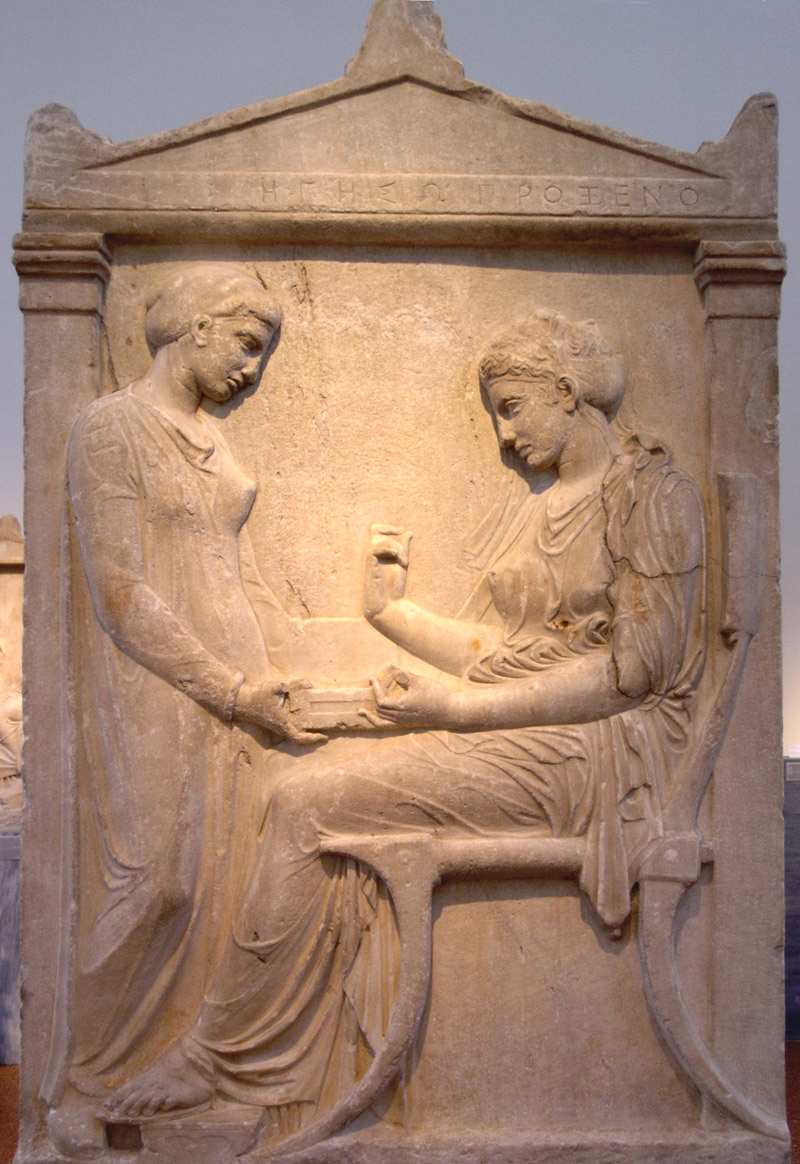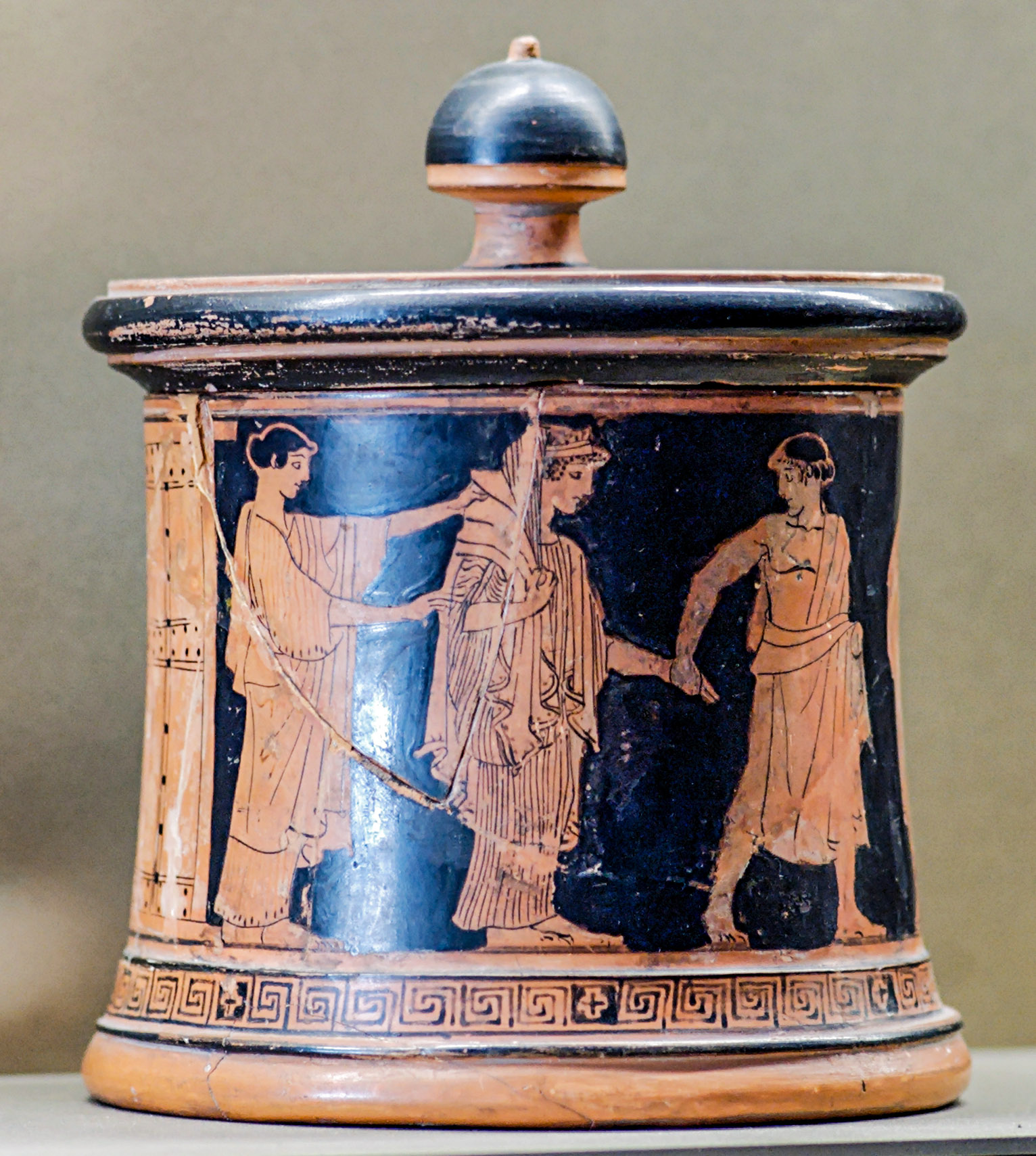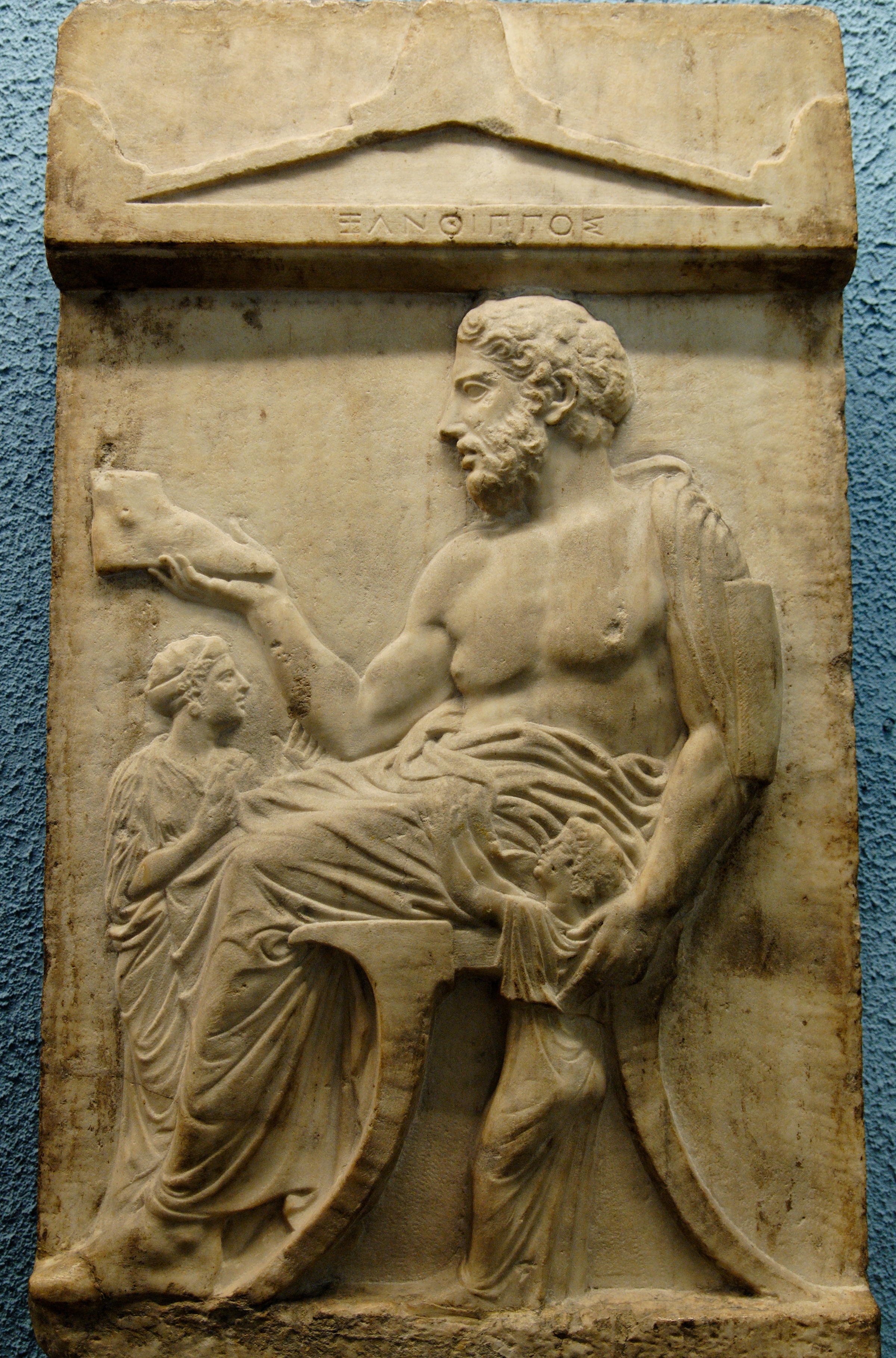|
Grave Stele Of Hegeso
The Grave Stele of Hegeso, most likely sculpted by Callimachus, is renowned as one of the finest Attic grave stelae surviving (mostly intact) today. Dated from ca. 410 – ca. 400 BCE, it is made entirely of Pentelic marble. It stands 1.49m high and 0.92m wide, in the form of a ''naiskos'', with pilasters and a pediment featuring palmette acroteria. The relief, currently on display at the National Archaeological Museum in Athens (NAMA 3624) was found in 1870 in the Kerameikos in Athens, which now houses a replica of it. In its current condition, it is almost complete, but has been restored around its edges. The plinth has mostly broken off and there is slight damage on the head of Hegeso. The main shows a mature Athenian woman (Hegeso) wearing a chiton (costume) and himation, seated on a chair with her feet resting on an elaborate footstool. In her left hand, she holds an open ''pyxis'', and in her right she holds a piece of (missing) jewelry that was originally painted, at whi ... [...More Info...] [...Related Items...] OR: [Wikipedia] [Google] [Baidu] |
Pyxis (vessel)
A ''pyxis'' (, plural ''pyxides'') is a shape of vessel from the classical world, usually a cylindrical box with a separate lid. Originally mostly used by women to hold cosmetics, trinkets or jewellery, surviving ''pyxides'' are mostly Greek pottery, but especially in later periods may be in wood, metal, ivory, or other materials. The name derived from Corinthian boxes made of wood from the tree ''puksos'' (boxwood), that also came with covers. The shape of the vessel can be traced in pottery back to the Protogeometric period in Athens, however the Athenian ''pyxis'' has various shapes itself. At first, the two varieties of ''pyxis'' included the pointed and the flat-bottomed. The pointed ''pyxis'' didn't last much longer than the ninth century BCE, while the flat-bottomed continued into the late Geometric. It also continued to grow larger and more squat in proportions. The cover often depicts elaborately sculpted handles and the walls tend to be somewhat convex. During the ... [...More Info...] [...Related Items...] OR: [Wikipedia] [Google] [Baidu] |
Funerary Steles
A funeral is a ceremony connected with the final disposition of a corpse, such as a burial or cremation, with the attendant observances. Funerary customs comprise the complex of beliefs and practices used by a culture to remember and respect the dead, from interment, to various monuments, prayers, and rituals undertaken in their honor. Customs vary between cultures and religious groups. Funerals have both normative and legal components. Common secular motivations for funerals include mourning the deceased, celebrating their life, and offering support and sympathy to the bereaved; additionally, funerals may have religious aspects that are intended to help the soul of the deceased reach the afterlife, resurrection or reincarnation. The funeral usually includes a ritual through which the corpse receives a final disposition. Depending on culture and religion, these can involve either the destruction of the body (for example, by cremation or sky burial) or its preservation (for examp ... [...More Info...] [...Related Items...] OR: [Wikipedia] [Google] [Baidu] |
Sophrosyne
Sophrosyne ( el, σωφροσύνη) is an ancient Greek concept of an ideal of excellence of character and soundness of mind, which when combined in one well-balanced individual leads to other qualities, such as temperance, moderation, prudence, purity, decorum, and self-control. An adjectival form is "sophron." It is similar to the concepts of '' zhōngyōng'' (中庸) of Chinese Confucianism and ''sattva'' () of Indian thought. Ancient Greek literature In Ancient Greek literature, sophrosyne is considered an important quality and is sometimes expressed in opposition to the concept of hubris. A noted example of this occurs in Homer's ''The Iliad''. When Agamemnon decides to take the queen Briseis away from Achilles, it is seen as Agamemnon behaving with hubris and lacking sophrosyne.North, Helen. 1966. ' (''Cornell Studies in Classical Philology'' 35). Ithaca: Cornell University Press. . . In Homer's ''Odyssey'', Odysseus avoids being turned by Circe the enchantress into an ... [...More Info...] [...Related Items...] OR: [Wikipedia] [Google] [Baidu] |
Klismos
A klismos (Greek: κλισμός) or klismos chair is a type of ancient Greek chair, with curved backrest and tapering, outcurved legs. Ancient Greece Klismoi are familiar from depictions of ancient furniture on painted pottery and in bas-reliefs from the mid-fifth century BCE onwards. In epic, ''klismos'' signifies an armchair, but no specific description is given of its form; in ''Iliad'' xxiv, after Priam's appeal, Achilles rises from his ''thronos'', raises the elder man to his feet, goes out to prepare Hector's body for decent funeral and returns, to take his place on his ''klismos''. A vase-painting of a satyr carrying a klismos chair on his shoulder shows how light such chairs were. The curved, tapered legs of the klismos chair sweep forward and rearward, offering stability. The rear legs sweep continuously upward to support a wide concave backrest like a curved tablet, which supports the sitter's shoulders, or which may be low enough to lean an elbow on. The long and elega ... [...More Info...] [...Related Items...] OR: [Wikipedia] [Google] [Baidu] |
Funerary Stele Of Hegeso On The Kerameikos In Athens
A funeral is a ceremony connected with the final disposition of a corpse, such as a burial or cremation, with the attendant observances. Funerary customs comprise the complex of beliefs and practices used by a culture to remember and respect the dead, from interment, to various monuments, prayers, and rituals undertaken in their honor. Customs vary between cultures and religious groups. Funerals have both normative and legal components. Common secular motivations for funerals include mourning the deceased, celebrating their life, and offering support and sympathy to the bereaved; additionally, funerals may have religious aspects that are intended to help the soul of the deceased reach the afterlife, resurrection or reincarnation. The funeral usually includes a ritual through which the corpse receives a final disposition. Depending on culture and religion, these can involve either the destruction of the body (for example, by cremation or sky burial) or its preservation (for examp ... [...More Info...] [...Related Items...] OR: [Wikipedia] [Google] [Baidu] |
Deme
In Ancient Greece, a deme or ( grc, δῆμος, plural: demoi, δημοι) was a suburb or a subdivision of Athens and other city-states. Demes as simple subdivisions of land in the countryside seem to have existed in the 6th century BC and earlier, but did not acquire particular significance until the reforms of Cleisthenes in 508 BC. In those reforms, enrollment in the citizen-lists of a deme became the requirement for citizenship; prior to that time, citizenship had been based on membership in a phratry, or family group. At this same time, demes were established in the main city of Athens itself, where they had not previously existed; in all, at the end of Cleisthenes' reforms, Athens was divided into 139 demes, to which one can be added Berenikidai (established in 224/223 BC), Apollonieis (201/200 BC), and Antinoeis (added in 126/127). The establishment of demes as the fundamental units of the state weakened the ''gene'', or aristocratic family groups, that had dominated t ... [...More Info...] [...Related Items...] OR: [Wikipedia] [Google] [Baidu] |
Demetrius Of Phalerum
Demetrius of Phalerum (also Demetrius of Phaleron or Demetrius Phalereus; grc-gre, Δημήτριος ὁ Φαληρεύς; c. 350 – c. 280 BC) was an Athenian orator originally from Phalerum, an ancient port of Athens. A student of Theophrastus, and perhaps of Aristotle, he was one of the first members of the Peripatetic school of philosophy. Demetrius had been a distinguished statesman who was appointed by Cassander, the King of Macedon, to govern Athens, where Demetrius ruled as sole ruler for ten years. During this time, he introduced important reforms of the legal system, while also maintaining pro-Cassander oligarchic rule. Demetrius was exiled by his enemies in 307 BC. He first went to Thebes, and then, after 297 BC, went to the court of Alexandria. He wrote extensively on the subjects of history, rhetoric, and literary criticism. He is not to be confused with his grandson, also called Demetrius of Phaleron, who probably served as regent of Athens between 262 and 255, ... [...More Info...] [...Related Items...] OR: [Wikipedia] [Google] [Baidu] |
Peloponnesian War
The Peloponnesian War (431–404 BC) was an ancient Greek war fought between Athens and Sparta and their respective allies for the hegemony of the Greek world. The war remained undecided for a long time until the decisive intervention of the Persian Empire in support of Sparta. Led by Lysander, the Spartan fleet built with Persian subsidies finally defeated Athens and started a period of Spartan hegemony over Greece. Historians have traditionally divided the war into three phases. The first phase (431–421 BC) was named the Ten Years War, or the Archidamian War, after the Spartan king Archidamus II, who launched several invasions of Attica with the full hoplite army of the Peloponnesian League, the alliance network dominated by Sparta. However, the Long Walls of Athens rendered this strategy ineffective, while the superior navy of the Delian League (Athens' alliance) raided the Peloponnesian coast to trigger rebellions within Sparta. The precarious Peace of Nicias was si ... [...More Info...] [...Related Items...] OR: [Wikipedia] [Google] [Baidu] |
Polis
''Polis'' (, ; grc-gre, πόλις, ), plural ''poleis'' (, , ), literally means "city" in Greek. In Ancient Greece, it originally referred to an administrative and religious city center, as distinct from the rest of the city. Later, it also came to mean the body of citizens under a city's jurisdiction. In modern historiography, the term is normally used to refer to the ancient Greek city-states, such as Classical Athens and its contemporaries, and thus is often translated as "city-state". The ''poleis'' were not like other primordial ancient city-states like Tyre or Sidon, which were ruled by a king or a small oligarchy; rather, they were political entities ruled by their bodies of citizens. The Ancient Greek ''poleis'' developed during the Archaic period as the ancestor of the Ancient Greek city, state and citizenship and persisted (though with decreasing influence) well into Roman times, when the equivalent Latin word was '' civitas'', also meaning "citizenhood", whi ... [...More Info...] [...Related Items...] OR: [Wikipedia] [Google] [Baidu] |
Oikos
The ancient Greek word ''oikos'' (ancient Greek: , plural: ; English prefix: eco- for ecology and economics) refers to three related but distinct concepts: the family, the family's property, and the house. Its meaning shifts even within texts. The ''oikos'' was the basic unit of society in most Greek city-states. In normal Attic usage the ''oikos'', in the context of families, referred to a line of descent from father to son from generation to generation. Alternatively, as Aristotle used it in his ''Politics'', the term was sometimes used to refer to everybody living in a given house. Thus, the head of the ''oikos'', along with his immediate family and his slaves, would all be encompassed. Large ''oikoi'' also had farms that were usually tended by the slaves, which were also the basic agricultural unit of the ancient Greek economy. Layout Traditional interpretations of the layout of the ''oikos'' in Classical Athens have divided into men's and women's spaces, with an area know ... [...More Info...] [...Related Items...] OR: [Wikipedia] [Google] [Baidu] |






_-_Thucydides.jpg)

